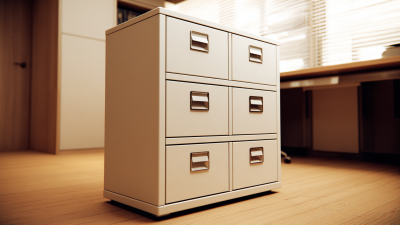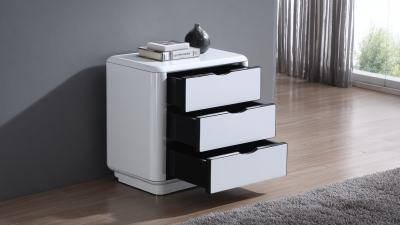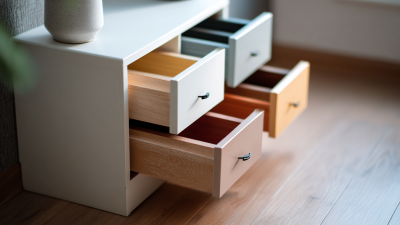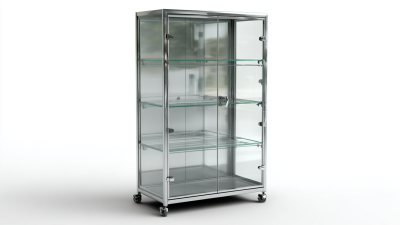When it comes to organizing your workspace or home environment efficiently, a well-chosen 3 Drawer Cabinet can make all the difference. According to a recent report by the International Furniture Manufacturers Association (IFMA), nearly 60% of professionals identify clutter as a significant obstacle to productivity. Furthermore, the demand for versatile storage solutions has surged by 25% in the last five years, indicating a growing need for effective organizational tools. A 3 Drawer Cabinet not only provides ample space for documents and supplies but also enhances the aesthetic appeal of your office or living area. With a variety of designs, materials, and functionality options available, selecting the perfect 3 Drawer Cabinet requires careful consideration to meet both your practical needs and style preferences. This guide will help you navigate the choices to find the ideal cabinet that complements your space while boosting your efficiency.

When selecting the perfect 3 drawer cabinet for your home or office, understanding dimensions is crucial for optimal space utilization. According to a report by the American Institute of Architects, proper space planning can enhance productivity by up to 20%. This finding highlights the importance of choosing a cabinet that not only fits your spatial limitations but also complements your workflow needs.
Typically, 3 drawer cabinets range in size from 24 to 36 inches in width and 18 to 20 inches in depth. Selecting a cabinet that aligns with your available space can prevent clutter and create a more organized environment. A study from the National Association of Professional Organizers indicates that 80% of people feel more productive in organized spaces. Thus, carefully considering the dimensions and configuration of your cabinet can significantly impact both your efficiency and the overall aesthetics of your workspace.

When selecting the perfect 3 drawer cabinet for your home or office, the material is a key aspect that greatly influences both durability and aesthetics. Wood offers a classic and warm appeal, ideal for spaces that emphasize a traditional or rustic look. High-quality hardwoods, such as oak or maple, tend to resist wear and tear, whereas softwoods like pine may be more susceptible to dents and scratches. However, wooden cabinets require regular maintenance, including polishing and occasional refinishing, to maintain their charm.
On the other hand, metal cabinets provide a modern and sleek option that is incredibly durable. They are impervious to moisture and easy to clean, making them perfect for high-traffic areas or spaces prone to spills. Additionally, metal cabinets typically come in a variety of colors and finishes, allowing for customization to fit various design schemes. Be sure to consider the weight of the drawers and ease of movement, as heavier metal can sometimes be cumbersome.
For a lightweight and budget-friendly alternative, plastic cabinets are worth considering. They are resistant to water and stains, and their lightweight nature makes them easy to transport. However, it's important to check the quality of the plastic, as some cheaper options may warp or fade over time. When choosing a material, think about the specific needs of your space, such as the cabinet's purpose and the overall design aesthetics.
Tips: Always assess the cabinet's functionality along with style. Look for cabinets with strong drawer slides and locks if you need to store sensitive documents. Ensure that the cabinet complements the existing decor to create a cohesive look in your space.
When selecting a three-drawer cabinet for your home or office, understanding drawer weight capacity is crucial for ensuring that the unit meets your storage needs. Each drawer will have a specific weight limit, which can vary based on the materials used and the design of the cabinet.
For instance, while metal cabinets may support heavier items due to their robust construction, wooden cabinets often have lower weight capacities. It’s essential to consider what items you plan to store and choose a cabinet that can accommodate them without risking damage to the drawer mechanisms.
Additionally, evaluating the distribution of weight within the cabinet is key to maintaining functionality over time. Overloading a single drawer can lead to issues such as tipping or jamming, which can decrease the lifespan of the cabinet. Consider organizing heavier items in the lower drawers where they can benefit from the stability of the unit. Paying attention to these details will ensure that the cabinet not only meets your storage requirements but also operates smoothly, allowing for a more organized and efficient space in your home or office.
When selecting a 3 drawer cabinet, it's essential to consider how its style and design will blend with your existing interior décor. Whether your home or office features a modern minimalist look or a classic traditional aesthetic, the right cabinet can enhance the space. For a contemporary setting, opt for sleek lines and materials like metal or glass. In contrast, for a rustic vibe, wooden cabinets with natural finishes can create warmth and charm.
**Tips:** To achieve a cohesive look, pay attention to colors and textures. Choose a cabinet that either complements or contrasts with your existing furniture, keeping in mind the overall color palette of the room. For instance, a white cabinet can brighten up a darker space, while a dark wood finish can add sophistication to lighter surroundings.
Additionally, consider the cabinet's functionality. A stylish cabinet that meets your storage needs will not only serve its purpose but also enhance the visual appeal of your environment. Accessories such as decorative handles or unique drawer pulls can also add a personal touch, reflecting your taste and making the cabinet a standout piece in your home or office.
When selecting the perfect 3 drawer cabinet for your home or office, budget considerations are crucial. An analysis of cost versus quality reveals that investing in quality cabinetry can lead to significant long-term value. According to industry reports, while the average cost of cabinetry can range from $100 to $1,200 per linear foot, opting for higher-quality materials often results in better durability and functionality, ultimately saving you money on repairs and replacements in the long run.

A 2025 cost guide indicates that homeowners in areas like Tampa Bay may spend between $15,000 and $50,000 on kitchen and bathroom renovations, with cabinetry accounting for a significant portion of that budget. By prioritizing quality over budget-friendly options, consumers can enhance not only the aesthetic appeal of their spaces but also the overall resale value of their homes. Reports suggest that well-made cabinets can elevate a remodel's ROI by up to 80%, making them a wise investment for anyone looking to optimize their living or working environment.






